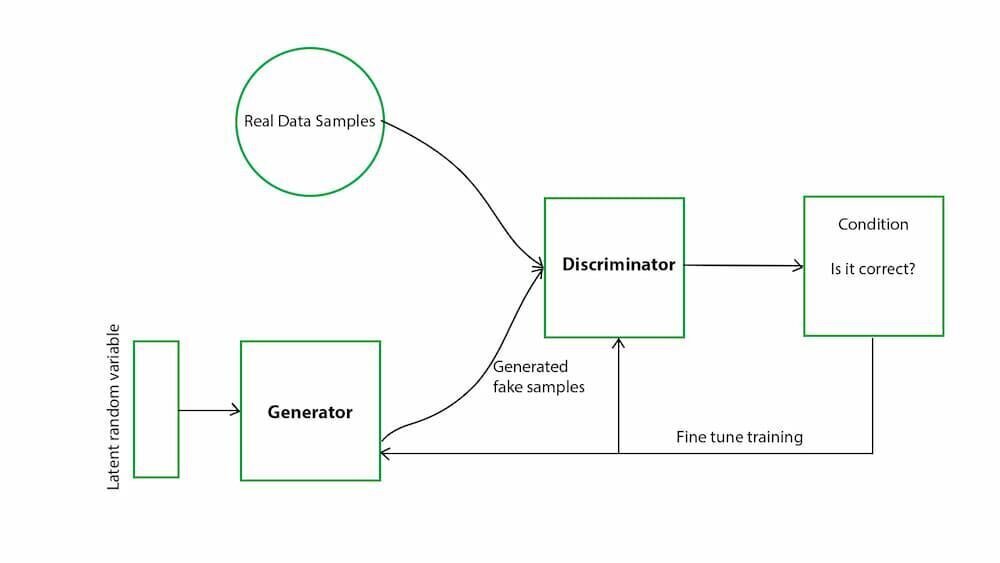Generative Adversarial Networks (GANs) are a groundbreaking class of machine learning models that have revolutionized the field of generative modeling. They consist of two neural networks, the generator and the discriminator, which are trained simultaneously through a process known as adversarial training.
Architecture of GANs
In a GAN, the generator’s role is to create synthetic data that mimics real data, while the discriminator evaluates the authenticity of the generated data against real data. This setup creates a competitive environment where the generator strives to produce data that is indistinguishable from real examples, and the discriminator aims to accurately identify whether the data is real or generated. The training continues until the discriminator is fooled about half the time, indicating that the generator has learned to produce highly realistic data[1][2][3].
How GANs Work
The training process can be viewed as a two-player minimax game:
-
Generator: The generator takes random noise as input and transforms it into data samples. Its objective is to maximize the probability of the discriminator making a mistake.
-
Discriminator: The discriminator receives both real data and generated data, aiming to minimize its classification error. It learns to differentiate between the two types of data[2][5].
This adversarial process leads to the generator improving its output quality over time, resulting in high-fidelity synthetic data. GANs have shown exceptional performance in various applications, including image synthesis, style transfer, and even generating 3D models from 2D images[3][4].
Applications of GANs
GANs have a wide range of applications across different domains:
-
Image Generation: GANs can create realistic images of faces, objects, and scenes that do not exist in reality. This has implications in fields like digital art, gaming, and virtual reality[1][3].
-
Data Augmentation: They can generate synthetic data to augment training datasets, which is particularly useful in scenarios where data is scarce or expensive to obtain[4].
-
Image-to-Image Translation: GANs can transform images from one domain to another, such as converting summer landscapes to winter scenes or black-and-white images to color[2][4].
-
Medical Imaging: In healthcare, GANs assist in generating high-resolution medical images from low-resolution inputs, aiding in diagnostics and treatment planning[1][4].
Advantages and Challenges
Advantages
-
High-Quality Output: GANs can produce photorealistic results, making them suitable for creative applications.
-
Unsupervised Learning: They can learn from unlabelled data, which is advantageous when labeled datasets are not available.
-
Versatility: GANs can be adapted for various tasks, including text generation and video synthesis[1][3][4].
Challenges
-
Training Instability: The adversarial nature of GANs can lead to training difficulties, such as mode collapse, where the generator produces a limited variety of outputs.
-
Computationally Intensive: Training GANs can require significant computational resources, especially for high-resolution data[1][2].
-
Bias and Fairness: GANs can inadvertently learn biases present in the training data, leading to ethical concerns in their applications[1][4].
Generative Adversarial Networks represent a significant advancement in machine learning, offering powerful tools for data generation and manipulation while also presenting unique challenges that researchers continue to address.
Further Reading
1. Generative Adversarial Network (GAN) – GeeksforGeeks
2. A Gentle Introduction to Generative Adversarial Networks (GANs) – MachineLearningMastery.com
3. 简介 | Machine Learning | Google for Developers
4. 什么是 GAN?- 生成对抗网络详解 – AWS
5. A basic intro to GANs (Generative Adversarial Networks) | by Sylvain Combettes | Towards Data Science
Description:
Generating new data samples by training two neural networks in opposition.
IoT Scenes:
Data augmentation, simulation, and model training.
Data Augmentation: Generating synthetic data to enhance training datasets for models.
Simulation: Creating realistic simulations for IoT systems and environments.
Data Privacy: Generating synthetic data to protect sensitive information.
Anomaly Detection: Identifying anomalies by comparing real data to generated samples


